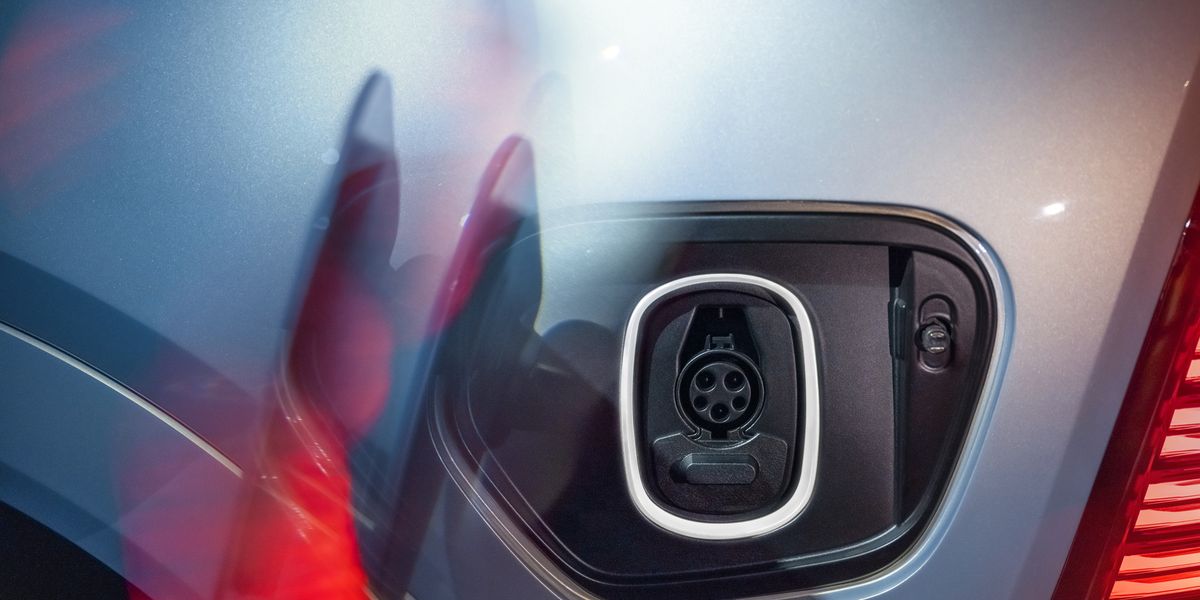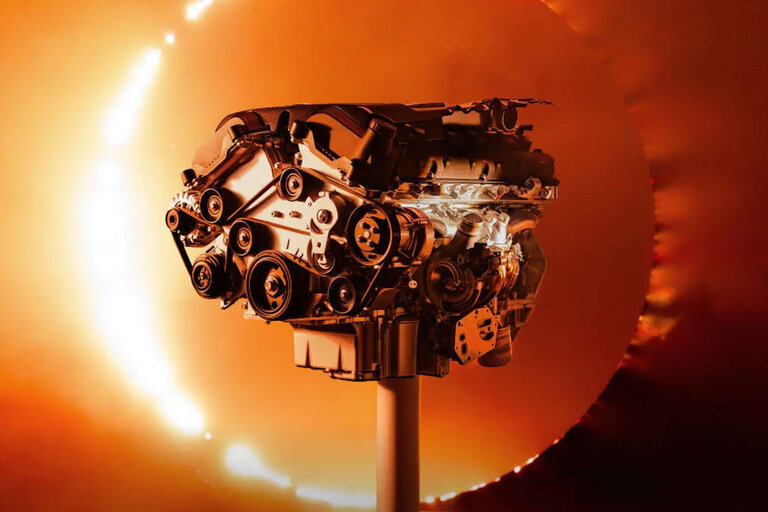
- On Wednesday in New York City, the wraps came off the 2025 Cadillac Escalade IQ.
- The new Escalade is a full-size battery-electric SUV with three rows of seats, all the luxury Cadillac can offer (for under $340,000, anyway), and a projected 450 miles of range.
- At the unveiling event, several Cadillac executives and GM president Mark Reuss spoke with Car and Driver about the car’s technology and its place in the market. Here’s what we learned.
The 2025 Cadillac Escalade IQ does carry Cadillac badges and have its own sheetmetal, shape, and interior, but the underpinnings of the Escalade IQ are actually straight from the GMC Hummer EV. To be fair, both are from GM’s Ultium modular battery architecture, which comes in a remarkable variety of sizes and formats—from the hulking, absurdly fast Hummer EV all the way down to a future generation of Chevrolet Bolt EV. The same platform used by the IQ also underpins the Chevy Silverado EV pickup truck and its counterpart, the GMC Sierra EV.
The electric Escalade’s specifications will sound awfully familiar to any Hummer EV owner, though. It has the same 24 battery modules as the Hummer EV pickup, providing more than 200 kilowatt-hours of energy, front and rear motor units, rear-wheel steering, and 800-volt charging (but not operating) capability as the electric off-roader.
Wheelbases of the electric Hummer pickup and the Escalade differ by less than an inch, but that Hummer offers quicker acceleration: 3.0 seconds to 60 mph using the special “Watts to Freedom” (WTF) mode, while the Cadillac’s zero-to-60 time is quoted at “less than five seconds” with its own special mode, which has the more dignified name of Velocity Max.
Second Escalade IQ Version?
GM president Mark Reuss very briefly teased the idea that in the future, a second variant of the Escalade IQ might appear, “for those buyers who want more room.” Asked if he meant a stretch version like today’s Escalade ESV, Reuss grinned. “I didn’t say bigger,” he said. Then he changed the subject.
Different Proportions, Less Intimidating
The IQ that debuted on Wednesday is visually more different than you might expect compared with the current Escalade, although the dimensions are similar. Its overall length of 224.3 inches is between that of today’s standard model and the stretched ESV (at 211.9 and 227.0 inches), while its 76.1-inch height is a fraction of an inch shorter and its width is also similar.
On the other hand, the IQ’s 136.2-inch wheelbase exceeds those of both the standard and ESV versions (120.9 and 134.1 inches, respectively), pushing the wheels to the corners as much as possible to allow more length for the battery between the two axles.
We didn’t get a chance to see the present and future Escalades side by side, where the differences in dimensions might have been more visible. But aerodynamics is a tough discipline; any EV must push aside as little air as possible to minimize the turbulence that causes drag and eats energy. GM claims the Escalade IQ is 15 percent more aerodynamic than any previous full-size SUV.
Importantly, in an era where the height of large trucks blocks drivers’ views of people outside the vehicles, the IQ’s cowl height of 54.0 inches above the ground equals that of the gasoline/diesel Escalade (by our rough measurements of each vehicle at the event). It should feel familiar to existing Escalade drivers, though the roofline falls toward the angled rear window.
Perceptually, it’s still a very large and imposing SUV. But the raked liftgate and the beveled nose with its smaller grille or shield make it somewhat less intimidating than the gasoline Escalade with a flatter hood and more bluff front end with its huge radiator intake. And the IQ certainly doesn’t have the long, square tail and upright liftgate of the gasoline versions.
Charging Ports
In the gallery of press images provided to reporters, there’s a shot of a fast-charging cord plugged into the Escalade IQ’s charging port. It’s very clearly the CCS standard that GM has used for eight years now. Wait, you say, didn’t General Motors announce in June it will switch over to the Tesla connector (known as NACS) and give its drivers access to the Tesla Supercharger network, following Ford’s similar groundbreaking announcement of the same thing the month before? Well, yes.
But, didn’t GM also announce it is among the seven automakers who have jointly committed to funding their own nationwide DC fast-charging network of 30,000 charging stations, starting next year—one that will use the CCS standard as well as the Tesla connector? Yes, that too.
To make matters even more confusing, one day before the Escalade IQ broke cover, GM said all Ultium vehicles will offer vehicle-to-home (V2H) backup-power capability, more formally known as bidirectional charging, by 2026. This ability is built into the spec for the CCS connector, but not the Tesla connector. While the Tesla plug is electrically capable of feeding power out, the company hasn’t implemented it, perhaps because Tesla sells PowerWall backup batteries to homeowners—and enabling its cars to serve the same function could damage that business. Nonetheless, the Escalade IQ promises V2H capability via an over-the-air software update during the 2025 model year.
We asked GM president Reuss about the state of the charging landscape today, and how we should sort all this out. He confirmed the adoption of the Tesla connector—”We’re doing it as fast as we can”—but also “compatibility with the SAE standard” (the Tesla connector is not actually a technical standard as yet). He did add the qualifier “for now” to CCS compatibility.
Okay, so does that mean future GM Ultium EVs will switch over from one connector to the other, or could they have both? “That will change with time,” Reuss said. “We don’t have a definitive answer today, on where it goes, what the ultimate [arrangement] is. We have to be able to do both.”
We surmise GM’s battery and charging engineers are digging into the Tesla plug and connector and software right now—trying to understand how it works, its safety margins, and how to make it compatible with vehicles that don’t run on Tesla OS software. Stay tuned on this one.
GM’s own Mobile Phone Interface
If you expect Android Auto or Apple CarPlay capability as a standard feature in any new car you consider, you’re out of luck for any of the upcoming GM vehicles on the Ultium architecture—including the Escalade IQ. GM will discontinue the standard phone mirroring capability starting with the 2024 Chevrolet Blazer EV, for which deliveries should start this quarter or next.
Car and Driver asked Reuss what will replace those functions. Under GM’s replacement systems, he said, drivers and passengers will be able to do everything they can do now using either of those two connectivity protocols. And he acknowledged the skepticism among reporters and vehicle shoppers on hearing the familiar Android Auto and Apple CarPlay would no longer work.
When reporters get access to the Blazer EV, sometime this fall, we’ll see how it works in practice. Until then, the jury is clearly out.
Tough Timing for GM
The Escalade IQ debut came at a tough time for GM. It has struggled to get its first high-volume Ultium cell plant, in Ohio, up to full-scale production to provide the volumes of cells needed to supply the tens of thousands of Ultium vehicles a month it projects it will sell by the end of the year.
In the words of one battle-scarred battery engineer, getting a new cell chemistry, in a new plant, with new staff, up and running at sufficient volume and acceptable yields, is “really, really, really, really, really, really, really hard”—and GM is doing that twice in one year. Reuss said the company is now “fully capacitized” at its first cell plant, with the second one in Spring Hill, Tennessee, following closely behind.
If so, the company’s EV sales figures for the third and fourth quarters of this year had better reflect it. For the first half of the year, the bulk of GM’s electric-car sales were the two-car lineup of aging Bolt EV and EUV models, both compact hatchbacks using a seven-year-old battery architecture. The Cadillac Lyriq and GMC Hummer EVs are already in production (though Hummer sales halted due to a months-long battery recall), and the Chevy Silverado EV, Blazer EV, and Equinox EV, plus the GMC Sierra EV, are hot on their heels—with the electric Escalade now added on top of that.
GM Goes Traditional, Follows Tesla
When GM developed the EV1 almost 30 years ago, it was a highly aerodynamic two-seater by necessity. The lead-acid battery technology of the time simply didn’t hold enough energy for its weight to propel a conventional four-seat vehicle. Then came the Toyota Prius, in several generations of increasingly odd-looking vehicles—and the Nissan Leaf which followed in 2010 was blatantly, distinctively unusual looking. It was also a compact hatchback, then the most popular vehicle type globally, if not in North America. GM’s own Chevrolet Volt was also a compact hatchback, with the additional complication of being a plug-in hybrid—a powertrain that to this day salespeople and shoppers don’t necessarily understand.
But throughout automotive history, new and advanced technologies have come in at the high end, either in luxury or sporting vehicles. From the first electric self-starter in 1912—on a Cadillac—to automatic transmissions, disc brakes, turbochargers, and all the rest, high-end vehicles offered more profit margin to offset the costs of the new technologies.
Tesla understood this; it started with a high-performance Roadster, at a six-figure price, then followed it with the mass-produced Model S at prices of $50,000 and above. Now GM, with its emphasis on the Hummer EV and Escalade IQ, plus their Silverado and Sierra EV pickup siblings, is putting its EV technology first into high-end vehicles as well.
Contributing Editor
John Voelcker edited Green Car Reports for nine years, publishing more than 12,000 articles on hybrids, electric cars, and other low- and zero-emission vehicles and the energy ecosystem around them. He now covers advanced auto technologies and energy policy as a reporter and analyst. His work has appeared in print, online, and radio outlets that include Wired, Popular Science, Tech Review, IEEE Spectrum, and NPR’s “All Things Considered.” He splits his time between the Catskill Mountains and New York City and still has hopes of one day becoming an international man of mystery.
#Cadillac #Escalade #IQs #Charging #Work #Progress
Source link





